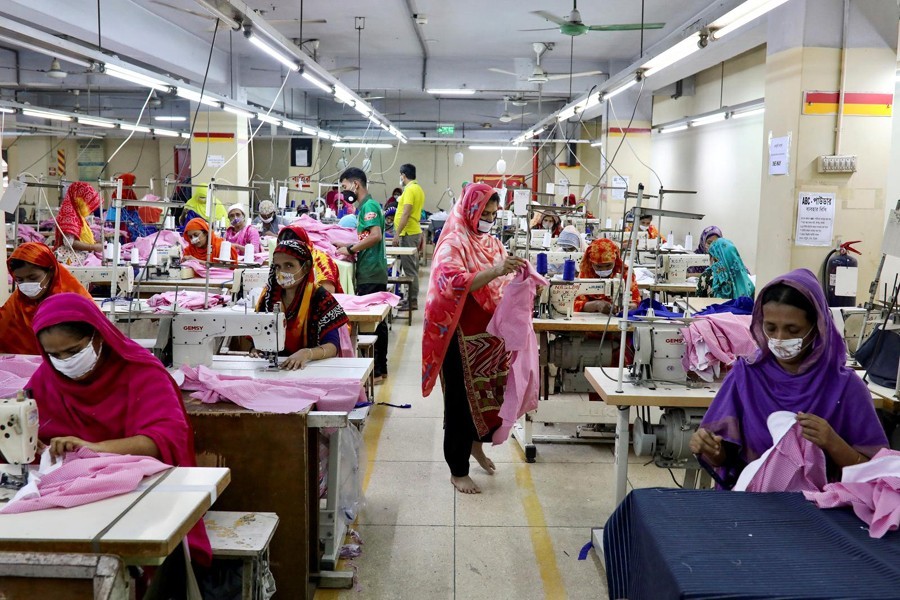Bangladesh could earn US$95 billion by 2030 from readymade garment (RMG) export, if the country can raise its manmade fibre (MMF)-based garment shipment along with the existing cotton-made items, according to a research paper.
Bangladesh would need to achieve 12 per cent and 20 per cent of the global MMF and cotton-based items' market share respectively for the said amount of export, it showed.
Bangladesh now captures less than 5.0 per cent and 16 per cent market share of the global MMF-based and cotton-based apparel goods respectively.
At present, almost half of the total global apparel exports are MMF products, while 42 per cent are cotton-based. In contrast, 72 per cent of Bangladesh's garment exports are cotton-based, while only 24 per cent are MMF.
In 2021, the global apparel market size was $440 billion, of which MMF-based apparel market was $222 billion or 51 per cent, and cotton-based was $190 billion or 42 per cent, it showed.
Research and Policy Integration for Development (RAPID) Chairman Dr M A Razzaque disclosed these statistics in his paper at a workshop - 'Man-Made Fibre for Moving up the Value Chain of RMG in the Context of LDC Graduation' - held in the city on Tuesday.
The workshop was jointly organised by Support to Sustainable Graduation Project (SSGP) of the Economic Relations Division (ERD) and the Bangladesh Garment Manufacturers and Exporters Association (BGMEA).
Planning Minister M A Mannan was present as the chief guest at the workshop, chaired by ERD Secretary Sharifa Khan.
Ministry of Commerce Additional Secretary Noor Md Mahbubul Haq, and BGMEA President Faruque Hassan attended as special guests.
Director of BGMEA Asif Ashraf gave a presentation on 'Challenges in Production and Use of MMF in RMG and Expectations of the Private Sector'.
Executive Director of Bangladesh Bank (BB) Kazi Rafiqul Hassan, Bangladesh Knitwear Manufacturers and Exporters Association (BKMEA) Executive President Mohammad Hatem, and Bangladesh Textile Mills Association (BTMA) Director Syed Nurul Islam also spoke on the occasion.
The RAPID chairman said the MMF items' demand is rising globally due to uncertainty in cotton production and supply, price comparability, environmental concerns, and use of pesticides and huge quantity of water.
Global consumption of fibre is heavily tilted towards MMF, and moving towards MMF can lead to improved product prices.
Now, MMF items comprise around 30 per cent of Bangladesh's total fibre import. The country currently imports about 0.15 million tonnes of MMF, mainly from China.
So, Bangladesh needs to develop its MMF backward linkage capacity, and more investment in the domestic MMF sector is needed, he opined.
The paper, however, suggested maintaining the dominance in cotton apparel export, saying MMF apparels can further drive export growth.
Making maximum use of the LDC privileges for the remaining few years, it recommended additional cash incentive for MMF apparel export and creating fiscal space to attract foreign investment in MMF textile and apparel sector to make Bangladesh as a regional MMF supply hub.
As the country's RMG sector is becoming bigger, it would be subjected to increased scrutiny, and ensuring compliance and ESG factors would influence future export performance, it noted.
Speaking on the occasion, the planning minister said switching to MMF would help the country to bring about increased diversification in the RMG sector.
He also observed that such transformation would strengthen backward linkage of the local RMG industry.
The ERD secretary said Bangladesh would have to grab the potentials of MMF items while maintaining the current growth in cotton export to increase its global market share.
Calling for enhancing competitiveness of the RMG sector to prepare for the post-LDC graduation, the BGMEA president emphasised simplification of relevant business processes and improvement in logistics.
Speakers opined that increased use of MMF would enable the country's RMG industry to diversify its products and move up the value chain, as the sector prepares for the post-LDC graduation regime.
Special policy incentives are needed to attract more investment in MMF-based textile and garment industry and grab larger share in the global apparel market.
The country would lose all the LDC-specific international support measures (ISMs) - including preferential Rules of Origin (RoO) and Duty-Free and Quota-Free (DFQF) market access, soon after the graduation from the LDC category in 2026 - except the Everything But Arms (EBA) scheme of the EU GSP, which will end in 2029.
Since Bangladesh could make maximum utilisation of the DFQF facilities, the loss of such facilities after graduation may create some challenges for local exports, particularly for the RMG, as the sector alone contributes around 83 per cent of the country's total export.


